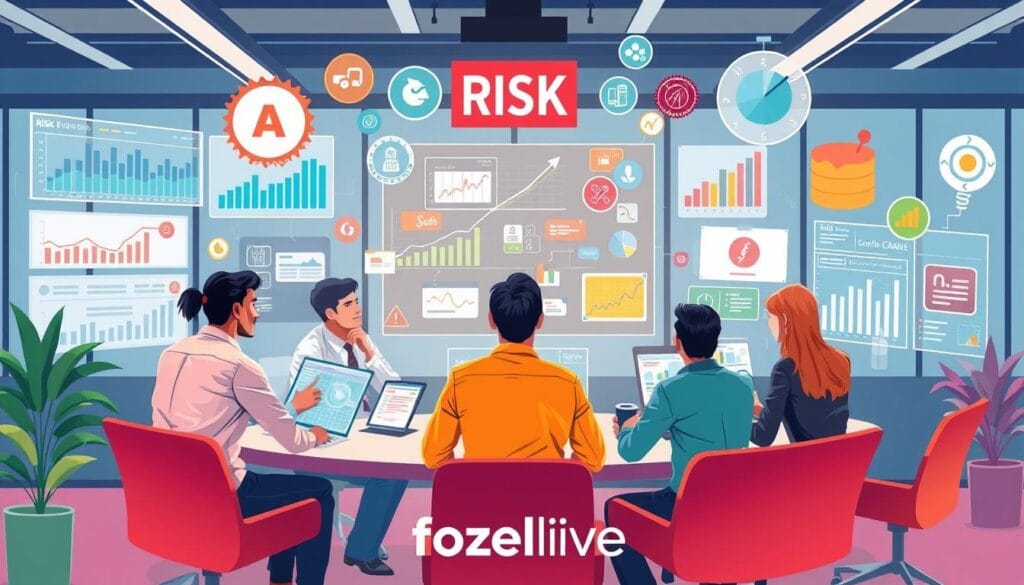בעולם העסקים המשתנה במהירות של היום, ניהול הסיכונים היטב הוא מרכזי לחברות כדי להישאר בטוחות, להפחית סיכונים ולהשגת הזדמנויות חדשות. מאמר זה מכסה את הרעיונות העיקריים ואת האסטרטגיות הממוצעות בעולם האמיתי של ניהול סיכונים. זה עוזר לעסקים להתמודד עם הסיכונים והלא ידוע שהם נתקלים בהם.
מסרים עיקריים
- ללמוד את היסודות של ניהול סיכונים ולמה זה חשוב להצלחה עסקית.
- ליצור תוכנית ניהול סיכונים מפורטת כדי לזהות, לבדוק ולהפחית סיכונים שונים.
- לגלות כיצד לזהות, לנתח ולדרג סיכונים כדי לקבל החלטות טובות יותר.
- להשתמש בדרכים ספציפיות להפחתת סיכונים, כמו בקרות סיכון, שיתוף סיכון ומניעת סיכונים.
- לקחת עמדה פרואקטיבית בצפייה על הסיכונים ולשפר תמיד כדי להישאר חזקים לטווח הארוך.
הבנת העצם של ניהול סיכונים
ניהול סיכונים הוא תהליך מרכזי. זה עוזר לזהות, לנתח ולהפחית סיכונים שעשויים להשפיע על מטרות הארגון. התהליך הזה חיוני לעסקים. זה עוזר להם לקבל החלטות חכמות, להגן על הנכסים שלהם ולשפר את הביצועים והרווחים.
מהו ניהול סיכונים?
ניהול סיכונים הוא על זיהוי, הערכה וטיפול בסיכונים בתוך ארגון. זהו שיטה מערכתית להבנת הסיכונים האפשריים, כמו סיכונים פיננסיים או תפעוליים. לאחר מכן, נוצרים תוכניות לניהול והפחתת הסיכונים האלה.
למה ניהול סיכונים חיוני לעסקים?
בעולם העסקים המשתנה במהירות של היום, ניהול סיכונים חשוב יותר מתמיד. זה עוזר לעסקים להתמודד עם אירועים בלתי צפויים ולשמור על מוניטציה חזקה. על ידי ביצוע הערכת סיכון וזיהוי סיכונים, חברות יכולות לתכנן לאתגרים. זה מביא להצלחתם ולצמיחה ארוכת טווח.
| היתרונות של ניהול סיכונים | התוצאות האפשריות של התעלמות מניהול סיכונים |
|---|---|
|
|
על ידי שימוש באסטרטגיית ניהול סיכונים חזקה, עסקים יכולים להתמודד עם אתגרי עולם העסקים היום טוב יותר. הגישה הזו עוזרת להם להישאר חזקים ולהכין את עצמם להצלחה לטווח ארוך.
פיתוח של מסגרת ניהול סיכונים מקיפה
ניהול סיכונים אפקטיבי הוא מפתח להצלחה עסקית. על ידי יצירת מסגרת ניהול סיכונים מפורטת, חברות יכולות לזהות, לבדוק ולהפחית סיכונים. זה עוזר לשמור על יציבות הפעולות שלהם ולגדול במהלך הזמן.
מסגרת ניהול סיכונים חזקה כוללת מספר חלקים חשובים:
- זיהוי סיכונים: תחילה, יש למצוא את כל הסיכונים שעשויים להשפיע על החברה. זה כולל דברים כמו שינויים בשוק ובעיות פנימיות.
- הערכת סיכונים: לאחר שמצאת את הסיכונים, עליך להבין כמה סבירים הם ואילו השלכות גדולות הם עשויים להיות. לאחר מכן, עליך למיין אותם לפי חומרתם.
- הפחתת סיכונים:
לדעת הסיכונים, החברה יכולה לתכנן להפחתתם או למניעתם.
- שליטה בסיכון: חשוב לשמור עין על היעילות של תוכניות אלה. לבצע שינויים אם נדרש.
- מעקב אחר סיכון: תמיד לשקול את הסיכונים ואיך החברה עוסקת בהם. זה עוזר לשמור על תוכנית ניהול הסיכון חזקה וגמישה.
שימוש ב-מסגרת ניהול סיכון מלאה עוזר לעסקים להתמודד עם הסיכונים בביטחון. בכך, הם יכולים לצמוח ולהצליח בטווח הארוך.

"ניהול סיכון אפקטיבי אינו על הסרת הסיכון, אלא על הבנתו וניהולו כדי להשיג מטרות ארגוניות."
| רכיבי מסגרת לניהול סיכונים | תיאור |
|---|---|
| זיהוי סיכונים | זיהוי מערכתי של כל הסיכונים האפשריים שעשויים להשפיע על הארגון. |
| הערכת סיכון | הערכת הסתברות והשפעה פוטנציאלית של כל הסיכונים שזוהו. |
| הקטנת סיכון | פיתוח ויישום אסטרטגיות ממוקדות להקטנת או להפחתת הסיכונים שזוהו. |
| שליטת סיכון | מעקב ואמצעים שליטה רציניים כדי להבטיח את יעילות מאמצי הקטנת הסיכון. |
| מעקב אחר סיכון | מעקב רציני אחר נוף הסיכונים ואחר תגובת הארגון להם. |
זיהוי סיכונים ושיטות להערכתם
הבנת הסיכונים שעומדים בפני עסקך היא מרכזית לניהול סיכונים טוב. שלבי זיהוי סיכון ו-הערכת סיכון הם חיוניים. הם עוזרים לעסק שלך להתמודד עם איומים ולהשתמש בהזדמנויות.
זיהוי סיכונים פוטנציאליים
כדי לזהות סיכונים, עסקים משתמשים בשיטות רבות, כגון:
- שיחת רעיונות עם אנשים חשובים
- צפייה בטרנדים בתעשייה והשוואה למתחרים
- ביצוע ניתוחי SWOT (חוזקות, חולשות, הזדמנויות, איומים)
- בדיקת נתונים ודוחות מהעבר של אירועים
- קבלת עצות ממומחים ומקצוענים בניהול סיכונים
הגישה הזו הרחבה עוזרת לזהות סיכונים בתוך החברה ומחוץ לה. זה משפיע על אופן ניהול ה-ניהול סיכוני תפעול וה-ניהול סיכוני פיננסי.
הערכת סיכון לפי תדירות והשפעה
לאחר שמצאנו סיכונים, אנו בודקים כמה סביר שהם יתרחשו ואת ההשפעה האפשרית שלהם. זה אומר:
- לנחש את הסיכוי של כל סיכון, באמצעות נתונים מהעבר, סטנדרטים בתעשייה ודעות מומחים.
- להביט בכמה רע כל סיכון יכול להיות, כמו אובדן כסף, פגיעה במוניטין והפרעות.
- למיין סיכונים לפי כמה סבירים וכמה גדולים יכולים להיות ההשלכות שלהם. זה עוזר להתמקד באיומים הגדולים ביותר.
על ידי ביצוע ניתוח סיכון מעמיק, עסקים יכולים לקבל החלטות חכמות. הם יכולים לתכנן להפחתת הסיכונים החשובים ביותר.

"ניהול סיכון אפקטיבי אינו על הסרת הסיכון, אלא על הבנתו וניהולו." – לא ידוע
אסטרטגיות ניהול סיכון אפקטיביות
הפעלת עסק דורשת ממך לנהל סיכונים בצורה יעילה. נבחן כיצד לטפל בסיכונים על ידי שימוש בבקרות סיכון והבטת מבנה בסיכונים.
העברת סיכון והימנעות.
יישום בקרות סיכון
הצבת בקרות סיכון חזקות היא מרכזית לניהול סיכונים בצורה יעילה. על ידי זיהוי סיכונים וצעדים לשליטה בהם, עסקים יכולים להוריד את הסיכון ואת ההשפעה של אירועים רעים. זה עשוי לכלול:
- יצירת כללים ברורים ושלבים להפחתת סיכונים
- הקמת מערכות בקרה בתוך החברה, כמו בדיקות פיננסיות ואבטחה
- הכשרת עובדים בצורה טובה לניהול סיכונים
- בדיקה ועדכון של בקרות הסיכון לעתים קרובות כדי להתאים לשינויים בעסק
העברת סיכון והימנעות מסיכון
לפעמים, עדיף להעביר או להימנע מסיכונים מסוימים. העברת סיכון אומרת להעביר את הסיכון למישהו אחר, כמו בביטוח או בחוזים. הימנעות מסיכון אומרת להפסיק או לא להתחיל פעילויות שהן יותר מדי סוחפות.
התבוננות ב-העברת סיכון והימנעות עשויים להפוך את החברות לחזקות יותר ולאפשר להן להתמקד במה שחשוב.

"ניהול סיכונים אפקטיבי אינו מדובר בהסרת סיכון, אלא במציאת האיזון הנכון בין סיכון והזדמנות."
ניהול סיכונים: גישה פרואקטיבית לניטור סיכונים
בעולם העסקים המשתנה במהירות של היום, ניהול סיכונים הוא יותר מזיהוי ותיקון בעיות. זה כרוך בהיות פרואקטיבי ותמיד מוכן להתאים. על ידי שימוש באסטרטגיות לניהול סיכוני עסקי, תפעולי ופיננסי, חברות יכולות להישאר מול המתחרים. הן יכולות להתמודד עם אתגרים חדשים ולהשגת הזדמנויות חדשות.
שמירה קרובה על הסיכונים עוזרת לעסקים לחזות ולהגיב לשינויים. זה כולל שינויים בשוק, כללים ואיך הדברים עובדים בתוך החברה. מנהיגים משתמשים בנתונים כדי לקבל החלטות חכמות, לכוון את תוכניות הסיכון שלהם, ולשמור על חברותיהם חזקות לטווח הארוך. בכך, הן יכולות להתמודד עם סיכונים לא ידועים, להימנע מבעיות גדולות, ולהישאר תחרותיות.
יצירת תרבות שמעריכה את המודעות לסיכון ותמיד משפרת, עוזרת לחברות לבנות מערכות ניהול סיכונים חזקות. גישה זו לא רק מגן נגד איומים, אלא גם פותחת דלתות לצמיחה ולרעיונות חדשים. היא מציבה את הבמה להצלחה ארוכת טווח בעולם מלא בשינויים.










